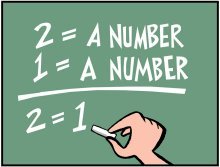
We know that (a+b)2=a2+2ab+b2.
Using the above identity,we proceed to prove an impossible task:Proving 0=1!
Try to figure out the fallacy in the below set of equations.Here we go:
(n+1)2=(n+1)2−(2n+1)=(n+1)2−(2n+1)−n(2n+1)=(n+1)2−(2n+1)(n+1)=(n+1)2−(2n+1)(n+1)+(22n+1)2=[(n+1)−22n+1]2=(n+1)−22n+1=n+1=n−n=0=n2+2n+1n2n2−n(2n+1)n2−n(2n+1)n2−n(2n+1)+(22n+1)2[n−22n+1]2n−22n+1n11…(1)…(2)…(3)…(4)…(5)…(6)…(7)…(8)…(9)…(10)
Could you figure it out? What do you think? Comment below!
#Algebra

Easy Math Editor
This discussion board is a place to discuss our Daily Challenges and the math and science related to those challenges. Explanations are more than just a solution — they should explain the steps and thinking strategies that you used to obtain the solution. Comments should further the discussion of math and science.
When posting on Brilliant:
*italics*or_italics_**bold**or__bold__paragraph 1
paragraph 2
[example link](https://brilliant.org)> This is a quote# I indented these lines # 4 spaces, and now they show # up as a code block. print "hello world"\(...\)or\[...\]to ensure proper formatting.2 \times 32^{34}a_{i-1}\frac{2}{3}\sqrt{2}\sum_{i=1}^3\sin \theta\boxed{123}Comments
Step (7) is wrong.
In simpler terms it's like (1)2=(−1)2⇒1=−1 (taking square root on both the sides). But don't forget that x2=∣x∣.
The same mistake is made in the journey from step (6) to step (7).
Log in to reply
That' right :)
7th step is wrong for the similar reason to Sandeep Bhardwaj. More ever it can be seen that LHS of the equality indicated in the 7th step is always positive while LHS is always negative.
If you have any more doubts on the subject,see this.